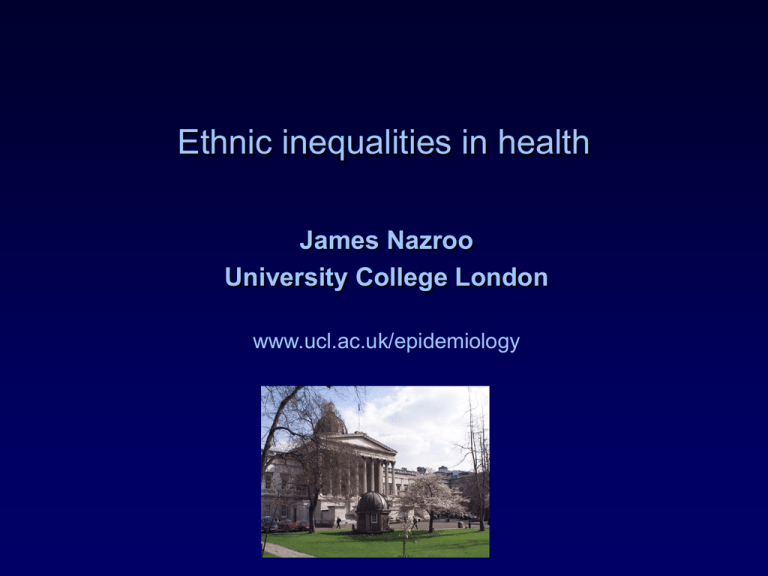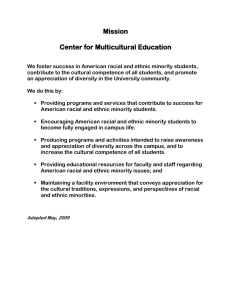Ethnic inequalities in health James Nazroo University College London www.ucl.ac.uk/epidemiology
advertisement

Ethnic inequalities in health James Nazroo University College London www.ucl.ac.uk/epidemiology Why is there an interest in ethnic inequalities in health? Aetiological investigations Monitoring Access to appropriate treatment Investigating inequalities in health Concern with ethnic disadvantage, racialisation and social inequalities: health as a component of wider disadvantage Reported fair or bad health by ethnic group and age Caribbean Indian Pakistani Bangladeshi Chinese White minority White English 100% 80% 60% 40% 20% 0% 2-5 5-9 10-12 13-15 16-20 21-25 26-30 31-35 36-40 41-45 46-50 51-60 61-70 > 70 Health Survey for England 1999 Reported fair or bad health Age adjusted odds ratio compared with white English Odds ratio (and 95% C.I.) 4 3.5 3 2.5 2 1.5 1 0.5 Caribbean Indian Pakistani Bangladeshi Chinese White minority Health Survey for England: Nazroo 2004 Explaining ethnic inequalities in health Statistical artifact Migration Differences in genetic risk Culture and lifestyle Material disadvantage Ecological effects Racism: exclusion and harassment Paradigms in research on ethnic differences in health (1) Un-theorised’ ethnicity Appears to be empirically driven Carries an implicit theory of fixed genetic and cultural difference Explanations are often reduced to racialised stereotypes Avoiding premature coronary deaths in Asians Asians’ evolutionary history involved adaptation ‘to survive under conditions of periodic famine’ leading to a high prevalence of insulin resistance. Central obesity may also develop as a consequence of lifestyle (culture): ‘a diet rich in saturated fats and energy (including ghee) and a sedentary lifestyle’. “Well Asian clinics” should be set up to address the low use of medical services. Community leaders should increase awareness of risk factors. Survivors should relay their experiences to members of their community. Dietary advice should be given and Asians should be encouraged to increase regular physical activity. Gupta et al. 1996 Paradigms in research on ethnic differences in health (2) Un-theorised’ ethnicity Appears to be empirically driven Carries an implicit theory of fixed genetic and cultural difference Explanations are often reduced to racialised stereotypes Ethnicity as structure Notions of fixed difference are used to justify exclusionary practices Racism Socioeconomic disadvantage Ethnic differences in occupational position Per cent Male employment rates Caribbean Indian 58 69 Pakistani Bangl- Chinese adeshi White White minority English 59 46 67 72 75 RG class of head of household I/II 23 36 25 13 45 46 34 IIInm 19 14 14 7 16 14 16 IIIm 27 26 33 39 28 24 30 IV/V 30 24 28 41 11 17 20 Health Survey for England 1999 Ethnic differences in equivalised household income Bottom tertile Middle tertile Top tertile 100% 80% 60% 90% 40% 69% 20% 48% 45% 41% 27% 31% White minority White English 0% Caribbean Indian Pakistani Bangladeshi Chinese Health Survey for England 1999 Experiences of racism and discrimination One in 8 ethnic minority people experience racial harassment in a year. Repeated racial harassment is a common experience. 25% of ethnic minority people say they are fearful of racial harassment. Modood et al. 1997 Experiences of racism and discrimination One in 8 ethnic minority people experience racial harassment in a year. Repeated racial harassment is a common experience. 25% of ethnic minority people say they are fearful of racial harassment. 20% of ethnic minority people report being refused a job for racial reasons, and almost 3/4 of them say it has happened more than once. 20% of ethnic minority people believe that most employers would refuse somebody a job for racial reasons, only 12% thought no employers would do this. Modood et al. 1997 Experiences of racism and discrimination One in 8 ethnic minority people experience racial harassment in a year. Repeated racial harassment is a common experience. 25% of ethnic minority people say they are fearful of racial harassment. 20% of ethnic minority people report being refused a job for racial reasons, and almost 3/4 of them say it has happened more than once. 20% of ethnic minority people believe that most employers would refuse somebody a job for racial reasons, only 12% thought no employers would do this. White people freely report their own prejudice: One in four say they are prejudiced against Asian people; One in five say they are prejudiced against Caribbean people. Modood et al. 1997 Equivalised income and fair or bad health 40% Bottom Tertile Middle Tertile Top Tertile 30% 20% 10% 0% Caribbean Indian Pakistani Bangladeshi Chinese White minority White English Health Survey for England 1999 Socioeconomic effects and fair or bad health Ln Odds ratio compared with white English Not adjusted for socioeconomic effects Adjusted for socioeconomic effects 1.4 1.2 1 0.8 0.6 0.4 0.2 0 Caribbean Indian Pakistani Bangladeshi Chinese White minority Health Survey for England 1999 Racism, discrimination, occupational class and health Predicted per cent reporting fair or poor health 50 40 30 20 10 0 None Verbal Physical or property Racial harassment No or a few Some or most Do employers discriminate? Nonmanual Manual Class (Karlsen and Nazroo 2002) Paradigms in research on ethnic differences in health (3) Un-theorised’ ethnicity Appears to be empirically driven Carries an implicit theory of fixed genetic and cultural difference Explanations are often reduced to racialised stereotypes Ethnicity as structure Notions of fixed difference are used to justify exclusionary practices Racism Socioeconomic disadvantage Ethnicity as identity Identification with cultural traditions Provides guidelines for action and psychological and material resources Both historical and immediate context influence identity – hybrid identities Tobacco use* tio n sh la Iri pu po er al an di se G en ck Bl a G en er al po Ca rib pu l be an at io n Iri Ch i es hi Ba n gl ad ki st an Pa In di be ne 0 Ch i 0 es hi 10 ad 10 i 20 gl 20 Ba n 30 ki st an 30 Women Pa 40 sh 40 ne se 50 i 50 an 60 an 60 Ca rib ck Bl a Any tobacco product In Cigarettes Men Health Survey for England 1999 *Use of chewing tobacco products was only asked of the South Asian groups Typologies of sexual lifestyle Jamaican African South Asian Sexual History Pre-coitarchy Single mongamy since before marriage/outside of marriage within marriage Serial monogamy within marriages only within and/or outside of marriage Multiple partnerships/encounters interleaved with monogamous relationships alongside primary relationships no primary/monogamous relationships ExES: Elam et al. 1999 Women looking after the home 80% 60% 40% 20% 0% Black Caribbean Indian Pakistani Bangladeshi Chinese Irish General population Smoking among South Asian People 35% 30% Indian Pakistani 11 years or older < 11 years Female Non-manual Male Manual Bangladeshi No FT worker 25% 20% 15% 10% 5% 0% Family Origin Age on Migration Gender Class Nazroo 1998 Ethnicity as a social identity race and ethnicity are intrinsically forms of collective social identity ... Identity confers a sense of personal location, and provides a stable core of individuality. But it is also about social relationships ... In exploring the dynamics of identity, we therefore need to understand the way in which identity grows out of and is transformed by action and struggle, and to ask: Who is constructing the categories and defining the boundaries? Who is resisting these constructions and definitions? What are the consequences of being written into or out of particular categories? What happens when subordinate groups seek to mobilize along boundaries drawn for the purposes of domination? What happens to individuals whose multiple identities may be fragmented and segmented by category politics? Solomos 1998 Ethnic making situations Enslavement of Africans leading to post-slavery societies – post slavery minorities. Colonial rule and post-colonial states – indigenous minorities, urban minorities (migrant worker populations) and ‘multi-cultural’ plural societies. Western capitalism and the formation of nation states – protonations (people who make a claim to be nations). Concluding comments Diversity of experiences across ethnic groups, classes, gender and generations. Ethnicity is a form of personal identity. Ethnicity/race is also an externally imposed identity. Ethnic identity is historically and socially contingent/constructed. Central role of social disadvantage in determining the pattern of ethnic inequalities in health.




